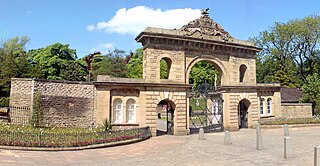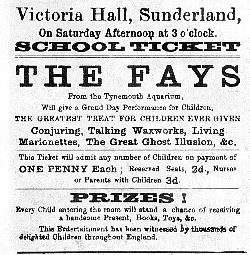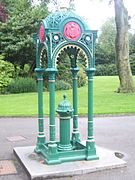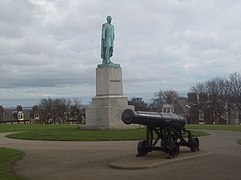
Hyde Park, Sydney, is an urban park, of 16.2-hectare (40-acre), located in the central business district of Sydney, in the City of Sydney local government area of New South Wales, Australia. It is the oldest public parkland in Australia. Hyde Park is on the eastern fringe of the Sydney city centre and is approximately rectangular in shape, being squared at the southern end and rounded at the northern end. It is bordered on the west by Elizabeth Street, on the east by College Street, on the north by St James Road and Prince Albert Road and on the south by Liverpool Street.

Sefton Park is a public park in south Liverpool, England. The park is in a district of the same name, located roughly within the historic bounds of the large area of Toxteth Park. Neighbouring districts include modern-day Toxteth, Aigburth, Mossley Hill, Wavertree and St Michael's Hamlet.

Major-General Sir Henry Havelock was a British general who is particularly associated with India and his recapture of Cawnpore during the Indian Rebellion of 1857.

Jack Crawford was a sailor of the Royal Navy known as the "Hero of Camperdown."

Kelvingrove Park is a public park located on the River Kelvin in the West End of the city of Glasgow, Scotland, containing the Kelvingrove Art Gallery and Museum.

Corporation Park is a traditional Victorian park in Blackburn, Lancashire, England. It was landscaped by William Henderson and opened in 1857. Corporation Park is regarded as the main formal park in Blackburn and is used mainly by local people for general recreation, walking and dog walking, as well as for its tennis, bowling and football facilities.

Princes Street Gardens are two adjacent public parks in the centre of Edinburgh, Scotland, lying in the shadow of Edinburgh Castle. The Gardens were created in the 1820s following the long draining of the Nor Loch and building of the New Town, beginning in the 1760s.

Bishopwearmouth is a former village and parish which now constitutes the west side of Sunderland City Centre, in the county of Tyne and Wear, England, merging with the settlement as it expanded outwards in the 18th and 19th centuries. It is home to the Sunderland Minster church, which has stood at the heart of the settlement since the early Middle Ages. Until 1974 it was in County Durham.

Holy Trinity Church is an Anglican church building in Sunderland, Tyne and Wear formerly the area's parish church. It was opened in 1719 as the church for the newly created Parish of Sunderland, and served the local community until dwindling numbers forced its closure in 1988. It has since been in the ownership of the Churches Conservation Trust who have preserved the space and converted it into a community cultural hub.

The Victoria Hall disaster occurred on 16 June 1883 at the Victoria Hall in Sunderland, England, when the distribution of free toys caused a crowd crush resulting in 183 children to be crushed to death due to compressive asphyxia.

The Sturt Street Gardens is a central reservation running along Sturt Street, one of the main thoroughfares of Ballarat,. The formal gardens span 13 city blocks from Grenville Street in the east to Pleasant Street in the west, are 20 metres (22 yd) wide and cover an area of 2.87 hectares running east–west.

Peel Park is a 22.6-hectare (56-acre) urban public park in the Bolton and Undercliffe area of Bradford, England, located about 0.75 miles (1.2 km) north-east of the city centre, and named after Sir Robert Peel (1788–1850). Peel Park was Bradford's first public park and is on the English Heritage and National Register of Historic Parks and Gardens online databases. The park is a Green Flag Award winner and has been for a number of years.

Bishopwearmouth Cemetery is a cemetery in Sunderland, Tyne and Wear, England. It lies between Hylton Road and Chester Road.

Memorials and monuments to victims of the sinking of the RMS Titanic exist in a number of places around the world associated with Titanic, notably in Belfast, Liverpool and Southampton in the United Kingdom; Halifax, Nova Scotia in Canada; and New York City and Washington, D.C. in the United States. The largest single contingent of victims came from Southampton, the home of most of the crew, which consequently has the greatest number of memorials. Titanic was built in Belfast, Northern Ireland, and had a "guarantee party" of engineers from shipbuilders Harland and Wolff aboard all of whom were lost in the disaster and are commemorated by a prominent memorial in the city. Other contingents of engineers aboard the ship came from the maritime cities of Liverpool in England and Glasgow in Scotland, which erected their own memorials. Several prominent victims, such as Titanic's captain, were commemorated individually. Elsewhere, in the United States and Australia, public memorials were erected to commemorate all the victims.

Queen's Park is a heritage-listed botanic garden at Sussex Street, Maryborough, Fraser Coast Region, Queensland, Australia. A reserve for the botanical gardens was gazetted in October 1873. It contains the Maryborough War Memorial. It was added to the Queensland Heritage Register on 21 October 1992.

A bronze statue of Henry Havelock by the sculptor William Behnes, stands in Trafalgar Square in London, United Kingdom. It occupies one of the four plinths in Trafalgar Square, the one to the southeast of Nelson's Column.

Anzac Memorial Park is a heritage-listed memorial and park at The Strand, Townsville CBD, City of Townsville, Queensland, Australia. It was first built in 1912. It is also known as The Strand Park and Townsville War Memorial. It was added to the Queensland Heritage Register on 21 October 1992.

The Princes Gardens is an urban park in the town of Aldershot in Hampshire. A short walk from the town centre on a site bordered by the town's High Street, Wellington Avenue and Princes Way and opposite the Princes Hall theatre, it has been a public park since 1930. Today the park is managed by Rushmoor Borough Council.

Barnes Park is a historic public park in Sunderland, Tyne and Wear, England. Taken together with its post-war extensions, which run to the former county borough boundary, it is the largest park in the city.

Sunderland City Centre is the central business district in Sunderland, Tyne and Wear, England. The city centre is just to the west of Sunderland Docks.




























